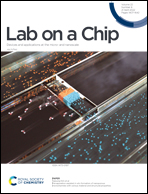Pervaporation-assisted in situ formation of nanoporous microchannels with various material and structural properties†
Abstract
Nanoporous structures are crucial for developing mixed-scale micro-/nanofluidic devices because they facilitate the manipulation of molecule transport along the microfluidic channel networks. Particularly, self-assembled particles have been used for fabricating various nanoporous membranes. However, previous self-assembly mechanisms relied on the material and structural homogeneities of the nanopores. Here, we present a pervaporation-assisted in situ fabrication method that integrates nanoporous membrane structures into microfluidic devices. The microfluidic devices contain a control-channel layer at the top, which induces local and addressable pervaporation, and the main-channel layer, which is present at the bottom with pre-designated locations for nanoporous microchannels; the layers are separated using a gas-permeable film. The target particle suspensions are loaded into the main channels, and their pervaporation is controlled through the gas-permeable film, which successfully assembles the particles at the pre-designated locations. This method yields nanoporous microchannels with various material and structural properties by fabricating heterogeneous nanopore arrays/junctions in series and other diverse structures along the microchannels. We validate the basic working principle of microfluidic devices containing nanoporous microchannels. Furthermore, we theoretically analyze the fundamental experimental results, which suggest the remarkable potential of our strategy to fabricate nanopore networks without using conventional nanofabrication methods.



 Please wait while we load your content...
Please wait while we load your content...